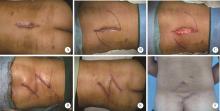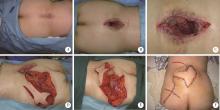Journal of Peking University (Health Sciences) ›› 2023, Vol. 55 ›› Issue (5): 910-914. doi: 10.19723/j.issn.1671-167X.2023.05.020
Previous Articles Next Articles
Plastic and reconstruction surgery for non-healing wound after posterior spinal surgery
Xin-ling ZHANG,Zhi-yu LIN,Yu-jie CHEN,Wen-fang DONG,Xin YANG*( )
)
- Department of Plastic Surgery, Peking University Third Hospital, Beijing 100191, China
CLC Number:
- R622.1
| 1 |
Glassman SD , Berven S , Bridwell K , et al. Correlation of radiographic parameters and clinical symptoms in adult scoliosis[J]. Spine, 2005, 30 (6): 682- 688.
doi: 10.1097/01.brs.0000155425.04536.f7 |
| 2 |
马超, 侯树勋. 成人退变性脊柱侧凸手术治疗的研究进展[J]. 中国骨与关节杂志, 2015, 4 (5): 426- 429.
doi: 10.3969/j.issn.2095-252X.2015.05.021 |
| 3 |
李建民, 李振峰. 中国脊柱肿瘤外科治疗存在问题及面临的挑战[J]. 中华骨科杂志, 2018, 38 (10): 577- 579.
doi: 10.3760/cma.j.issn.0253-2352.2018.10.001 |
| 4 |
Calis H , Sengul S , Guler Y , et al. Non-healing wounds: Can it take different diagnosis?[J]. Int Wound J, 2020, 17 (2): 443- 448.
doi: 10.1111/iwj.13292 |
| 5 |
Han G , Ceilley R . Chronic wound healing: A review of current management and treatments[J]. Adv Ther, 2017, 34 (3): 599- 610.
doi: 10.1007/s12325-017-0478-y |
| 6 |
胡永福, 何智萍, 陈万国, 等. 腓肠神经营养血管皮瓣修复足踝部软组织缺损创面[J]. 临床骨科杂志, 2016, 19 (1): 78- 80.
doi: 10.3969/j.issn.1008-0287.2016.01.032 |
| 7 |
Frykberg RG , Banks J . Challenges in the treatment of chronic wounds[J]. Adv Wound Care (New Rochelle), 2015, 4 (9): 560- 582.
doi: 10.1089/wound.2015.0635 |
| 8 |
Meng F , Cao J , Meng X . Risk factors for surgical site infections following spinal surgery[J]. J Clin Neurosci, 2015, 22 (12): 1862- 1866.
doi: 10.1016/j.jocn.2015.03.065 |
| 9 |
Kurtz SM , Lau E , Ong KL , et al. Infection risk for primary and revision instrumented lumbar spine fusion in the Medicare population[J]. J Neurosurg Spine, 2012, 17 (4): 342- 347.
doi: 10.3171/2012.7.SPINE12203 |
| 10 |
Rodgers WB , Gerber EJ , Patterson J . Intraoperative and early postoperative complications in extreme lateral interbody fusion an analysis of 600 cases[J]. Spine, 2011, 36 (1): 26- 32.
doi: 10.1097/BRS.0b013e3181e1040a |
| 11 |
Hadeed GJ , Smith J , O'keeffe T , et al. Early surgical intervention and its impact on patients presenting with necrotizing soft tissue infections: A single academic center experience[J]. J Emerg Trauma Shock, 2016, 9 (1): 22- 27.
doi: 10.4103/0974-2700.173868 |
| 12 | Wen G, Wang CY, Chai YM, et al. Distally based saphenous neurocutaneous perforator flap combined with vac therapy for soft tissue reconstruction and hardware salvage in the lower extremities[J]. 2013, 33(8): 625-630. |
| 13 | 王宇强, 冯世庆, 王小华, 等. 脊柱手术术后感染的病原菌和药敏分析及血清炎症因子的辅助诊断价值[J]. 中华医院感染学杂志, 2017, 27 (1): 147- 150. |
| 14 |
雒永生, 关永林, 杨巧林, 等. 脊柱手术患者切口感染病原菌流行特点及相关因子的辅助诊断价值分析[J]. 中国病原生物学杂志, 2019, 14 (7): 833- 836.
doi: 10.13350/j.cjpb.190720 |
| 15 | Aleem IS , Tan LA , Nassr A , et al. Surgical site infection prevention following spine surgery[J]. Global Spine J, 2020, 10 (Suppl 1): S92- S98. |
| 16 |
Zimmerli W . Orthopaedic implant-associated infections. Update of antimicrobial therapy[J]. Orthopade, 2015, 44 (12): 961- 966.
doi: 10.1007/s00132-015-3184-y |
| 17 | Zimmerli W, Moser CJ, Microbiology M. Pathogenesis and treatment concepts of orthopaedic biolm infections[J]. 2012, 65(2): 158-168. |
| 18 | 张喜海, 卓乃强, 鲁晓波. 游离组织瓣联合游离植皮负压封闭引流技术修复肢体严重创伤后大面积软组织缺损46例[J]. 重庆医学, 2014, 43 (1): 114- 116. |
| 19 | Fallico N, Somma F, Cigna E, et al. Coverage of exposed hardware after lower leg fractures with free flaps or pedicled flaps[J]. 2015, 19(24): 4715. |
| 20 | 傅荣, 小坂正明, 游晓波. 穿支动脉皮瓣修复骶尾部褥疮15例[J]. 中国修复重建外科杂志, 2008, 22 (1): 118- 120. |
| 21 |
朱金强, 沈柏晓, 雷云龙. 第四腰动脉穿支皮瓣治疗骶尾部小面积褥疮[J]. 中国修复重建外科杂志, 2013, 27 (12): 1531- 1532.
doi: 10.7507/1002-1892.20130335 |
| 22 |
Tchuenkam LW , Titcheu F , Mbonda A , et al. The gluteus maximus Ⅴ-Y advancement flap for reconstruction of extensive soft tissue loss following an advanced sacral pressure ulcer. A case report and mini review[J]. Int J Surg Case Rep, 2020, 73, 15- 21.
doi: 10.1016/j.ijscr.2020.06.060 |
| 23 |
Zoetmulder FA , Borger JH , Rutgers EJ , et al. Breast conserving therapy in patients with relatively large (T2, T3) breast cancers by preoperative irradiation and myocutaneous LD flap reconstruction. A new technique in breast conservation[J]. Eur J Cancer, 1993, 29 (7): 957- 961.
doi: 10.1016/S0959-8049(05)80201-1 |
| 24 |
Hundeshagen G , Zapata-Sirvent R , Goverman J , et al. Tissue rearrangements: The power of the Z-plasty[J]. Clin Plast Surg, 2017, 44 (4): 805- 812.
doi: 10.1016/j.cps.2017.05.011 |
| [1] | CAI Tian-yi,ZHANG Wen-bo,YU Yao,WANG Yang,MAO Chi,GUO Chuan-bin,YU Guang-yan,PENG Xin. Clinical analysis of selective tracheostomy necessary for patients undergoing head and neck surgery with free flap reconstruction [J]. Journal of Peking University (Health Sciences), 2022, 54(2): 363-368. |
|
||



